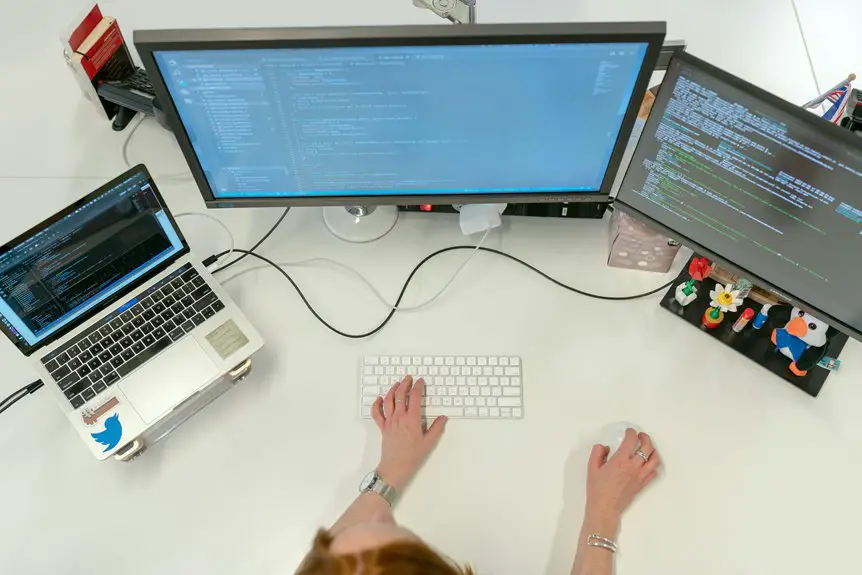When you decide to set up a portable monitor with your laptop, you're taking a step toward a more efficient workspace. It's not just about having more screen space; it's about enhancing your productivity. You'll need to consider the right monitor, the necessary cables, and how to connect everything seamlessly. But what comes next can really make a difference in your overall experience. Let's explore how to configure your display settings effectively.
Table of Contents
Key Takeaways
- Choose a portable monitor with a screen size of 15 to 17 inches and at least Full HD resolution for optimal usability.
- Use the appropriate cable (HDMI, USB-C, or DisplayPort) to connect your laptop to the monitor based on supported input options.
- Ensure your laptop's USB-C port supports video output if using a USB-C cable, or use an HDMI cable for easy connectivity.
- Connect the monitor to a power source if it requires external power, then turn it on to establish a connection.
- Access your computer's display settings to adjust resolution, orientation, and scaling for the best viewing experience.
Choosing the Right Portable Monitor
When you're in the market for a portable monitor, what factors should you consider?
First, think about the screen size. A 15 to 17-inch display strikes a good balance between portability and usability.
Next, check the resolution; at least Full HD (1920×1080) is ideal for clear visuals.
You'll also want to evaluate the monitor's weight and thickness for easy transport.
Consider connectivity options too—USB-C and HDMI ports are common and versatile.
Battery life matters if you'll use it away from power sources.
Lastly, read reviews to ensure the monitor meets your performance expectations.
Required Cables and Adapters
To connect your portable monitor, you'll need to know the various connection types it supports.
It's important to gather the essential cables and check for any adapter compatibility issues to ensure everything works smoothly.
Let's go over what you need to get your setup ready.
Monitor Connection Types
Choosing the right monitor connection type is essential for a seamless setup.
You'll find several options available, each with its advantages. It's crucial to know what your laptop and portable monitor support to avoid compatibility issues.
Here are some common connection types:
- HDMI: Widely used for its ability to transmit both video and audio.
- USB-C: Perfect for newer laptops, providing power and data transfer in one cable.
- DisplayPort: Great for high-resolution displays and supports multiple monitors.
- VGA: An older standard that may still be found in some devices, primarily for video only.
Make sure to check your devices' ports and choose the best connection type for optimal performance.
Essential Cable Types
Understanding monitor connection types sets the stage for knowing which cables and adapters you'll need for your portable monitor setup.
Most portable monitors connect via HDMI, USB-C, or DisplayPort. If your laptop has an HDMI output, grab an HDMI cable. For USB-C monitors, check if your laptop's USB-C port supports video output; if so, a simple USB-C cable will do.
If you're using a DisplayPort monitor, ensure your laptop has a compatible output or consider a USB-C to DisplayPort adapter. Keep in mind that some monitors might require additional power via USB, so check for a power cable too.
Having the right cables handy makes connecting your portable monitor seamless and hassle-free.
Adapter Compatibility Issues
While setting up your portable monitor, you might encounter adapter compatibility issues that can complicate your connection.
It's crucial to ensure you have the right cables and adapters to avoid frustration. Here are some common issues to watch out for:
- USB-C vs. HDMI: Not all USB-C ports support video output.
- Adapter Quality: Low-quality adapters may result in poor display performance.
- Resolution Limits: Some adapters can't handle higher resolutions, leading to blurry images.
- Power Supply: Certain portable monitors require external power, so check if your adapter provides it.
Connecting Your Portable Monitor
Connecting your portable monitor is a straightforward process that can enhance your productivity on the go.
First, find the appropriate cable based on your monitor's input options—commonly HDMI, USB-C, or DisplayPort. Plug one end of the cable into your laptop and the other into the monitor.
If your monitor requires power, connect it to a power source using the provided adapter. Once everything's plugged in, turn on your monitor, and you should see your laptop's display mirrored or extended automatically.
If it doesn't show up right away, check the connections and make sure the monitor is powered on.
You're now ready to enjoy the benefits of extra screen space while working or streaming on your portable monitor!
Configuring Display Settings
Once you've successfully connected your portable monitor, it's time to configure the display settings to optimize your viewing experience.
Start by accessing your computer's display settings. Here, you can adjust various parameters to enhance your setup.
- Resolution: Choose the appropriate resolution for your portable monitor to ensure crisp visuals.
- Orientation: Decide if you want the monitor in landscape or portrait mode based on your tasks.
- Multiple Displays: Select whether to extend your display or duplicate it, depending on how you want to use both screens.
- Scaling: Adjust the scaling settings to make text and images readable on your portable monitor.
With these adjustments, you'll enjoy a more productive and comfortable workspace.
Optimizing Your Workspace
After adjusting your display settings, it's time to optimize your workspace for maximum productivity.
Start by positioning your portable monitor at eye level, ensuring it's comfortable to view without straining your neck. Place your laptop beside the monitor to create an efficient workflow. Use a sturdy stand if necessary to elevate your laptop.
Keep your desk clutter-free; only have essential items within reach. Organize your cables with clips or ties to avoid distractions.
Adjust your seating position to promote good posture, and consider using a chair that provides support.
Lastly, ensure your workspace has adequate lighting to reduce eye strain.
With these adjustments, you'll create a conducive environment that enhances focus and efficiency.
Tips for Enhanced Productivity
Using a portable monitor can significantly boost your productivity, especially when you adopt a dual-screen workflow.
By setting up your screens optimally, you'll streamline your tasks and minimize distractions.
Let's explore how to arrange your monitors for the best results.
Dual-Screen Workflow Benefits
Two screens can transform your workflow by providing ample space for multitasking and organization.
With a dual-screen setup, you'll find it easier to manage multiple tasks simultaneously, boosting your overall productivity.
Here are some benefits you can expect:
- Increased Efficiency: Switch between applications without losing focus or time.
- Better Organization: Keep your email or chat open on one screen while you work on documents or presentations on the other.
- Enhanced Collaboration: Share your screen with colleagues while keeping your notes or reference materials visible.
- Reduced Eye Strain: Position your screens for comfortable viewing and reduce the need for constant scrolling or tab-switching.
Embrace the dual-screen advantage and watch your productivity soar!
Optimal Screen Arrangement
When it comes to setting up your portable monitor, the arrangement can make a significant difference in your productivity. To optimize your workspace, consider how your screens are positioned relative to each other. A common setup is to place the portable monitor to the side or above your laptop, aligning the tops of the screens for a seamless experience.
Here's a quick reference table for screen arrangement:
| Position | Purpose |
|---|---|
| Laptop Center | Main tasks and focus |
| Portable Left | Reference materials |
| Portable Right | Secondary tasks or chats |
| Above Laptop | Quick glance notifications |
Experiment with these arrangements to find what works best for you, and watch your efficiency soar!
Frequently Asked Questions
Can I Use a Portable Monitor With a Tablet or Smartphone?
Yes, you can use a portable monitor with a tablet or smartphone. Just ensure your device supports video output through USB-C or HDMI and connect accordingly. It expands your screen space for better multitasking and viewing!
What Is the Ideal Screen Size for a Portable Monitor?
The ideal screen size for a portable monitor typically ranges from 15 to 17 inches. This size balances portability with usability, making it easy for you to transport while providing an enjoyable viewing experience.
Are Portable Monitors Compatible With Gaming Laptops?
Yes, portable monitors are compatible with gaming laptops. You'll find that most gaming laptops support external displays, allowing you to enhance your gaming experience with additional screen real estate for better immersion and multitasking.
How Do I Power a Portable Monitor Without a Laptop?
You can power a portable monitor without a laptop by using a wall adapter or a power bank. Just connect the monitor's power input to your chosen power source, and it should work seamlessly.
Can I Connect Multiple Portable Monitors to One Laptop?
Yes, you can connect multiple portable monitors to one laptop, provided your laptop supports it. Use USB-C, HDMI, or DisplayPort connections, and ensure your laptop's graphics card can handle the additional displays effectively.



